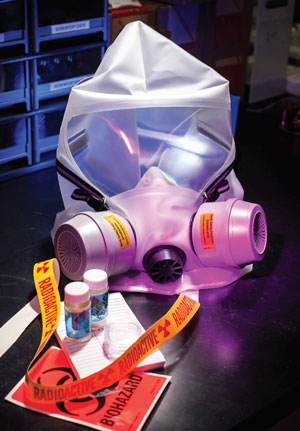Chemical, biological, radiological, nuclear, and explosive (CBRNE) materials pose significant threats to the United States and the world. The Forensic Science Center responds to threats posed by providing time-critical analyses for a wide range of hazards and unknown substances.
Since the Forensic Science Center (FSC) was founded in 1991, its scientists have been identifying challenging and complex samples for law enforcement and the intelligence community. Over time, the FSC’s unique capabilities in CBRNE analyses have established it as a premier laboratory that can answer an array of critical forensic questions—from cases of trace-level hazards to those requiring specialized analytical expertise—at national and international levels. This process of conducting rigorous analyses to identify samples from real-life cases is known as real-world sample exploitation.
Beyond CBRNE materials, the FSC carries out complex analyses for a much broader range of samples. It uses chromatography, mass spectrometry, nuclear magnetic resonance imaging, and other advanced techniques to determine the structures of unknown chemical compounds. FSC scientists utilize in-house expertise in chemical synthesis to confirm these structures. They also provide solid analytical data to support their results.
When asked to identify unusual samples that are outside their areas of expertise, FSC staff consult with scientists from other parts of the Laboratory. For example, scientists at the National Ignition Facility recently assisted the FSC in characterizing an optic, and staff at the Center for Micro- and Nanotechnology helped assess a novel material.
Supporting a Broad User Community
FSC began partnering with law enforcement agencies and the intelligence community in the early 1990s, following the demise of the former Soviet Union and increased trafficking of radioactive materials on the international black market. Its pioneering efforts in nuclear forensic analysis expanded the boundaries of analytical chemistry and contributed to establishing the field of forensic science.
The center, which has been conducting novel casework to detect weapons of mass destruction for more than 25 years, is ISO 17025 accredited. The FSC is a key partner laboratory used by the Federal Bureau of Investigation and other law enforcement agencies to analyze radioactive, nuclear, and explosive materials, nuclear and radiological contraband, and mixed-hazard samples (containing two or more types of materials). With the ability to perform chemical and biological analyses as well, the FSC supports the forensic needs of a wide variety of investigations led by law enforcement and the intelligence community. Moreover, it can analyze CBRNE materials or other samples collected anywhere in the world (with a round-the-clock response if necessary). In addition to characterizing materials for commercial partners, the FSC helps the International Atomic Energy Agency fulfill its mission to inhibit nuclear weapons proliferation—and support the peaceful use of nuclear technology worldwide—by analyzing samples for explosives and nuclear fission fragments.
Analyzing the Unknown
In investigations where standard sample preparation and analysis methods do not exist, the FSC can perform research and development in real time to create protocols that support sample identification. These efforts have included developing novel methods to analyze biomedical samples and creating complex extraction protocols for difficult soil types. While its analyses are often focused on screening for various known threats, the center also extensively interrogates samples to identify “unknowns” that are not contained in typical threat lists. This strategy allows the FSC to glean a more complete understanding of a sample, providing context and interpretation for authorities—even in the absence of a target threat chemical.
Creating Capacity in the Field
FSC has helped a sponsor develop the capability to conduct sample analyses in the field. To accomplish this goal, the center conducted instrument evaluations for several years to determine the appropriate equipment that should be deployed in field laboratories. These evaluations considered the functions of the instruments and the end users’ requirements (for example, enhanced ruggedness that can withstand transport). Once the FSC selected a standard kit of instruments, the center developed methods to conduct analyses for a wide range of threats (including chemical warfare agents, explosives, biological warfare agents, radiological and nuclear sources, opiates, poisons, and pharmaceuticals). To analyze samples in the chemical, radiological, and nuclear categories, the FSC designs instruments and can miniaturize those capabilities that are not readily available. As threats evolve, the center consistently updates its methods so that field laboratories can provide seamless, rapid, and accurate analysis. Field laboratory workers receive training in sample preparation and analysis, instrument maintenance, and troubleshooting.







